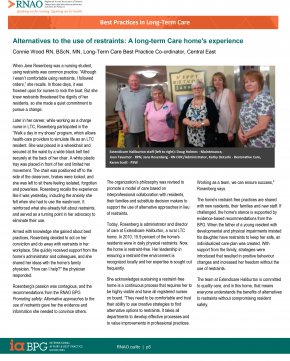Alternatives to the use of restraints: A long-term care home’s experience
When Jane Rosenberg was a nursing student using, restraints were a common practice. “Although I wasn’t comfortable using restraints, I followed orders,” she recalls. In those days, it was frowned upon for nurses to rock the boat. But she knew restraints threated the dignity of her residents, so she made a quiet commitment to pursue a change.
Later in her career, while working as a charge nurse in LTC, Rosenberg participated in the “Walk a day in my shoes” program, which allows health-care providers to simulate life as an LTC resident. She was placed in a wheelchair and secured at the waist by a wide black belt tied securely at the back of her chair. A white plastic tray was placed in front of her and limited her movement. The chair was positioned off to the side of the classroom, brakes were locked and she was left to sit there feeling isolated, forgotten and powerless. Rosenberg recalls the experience like it was yesterday, including the anxiety she felt when she had to sue the washroom. It reinforced what she felt about restraints, and served as a turning point in her advocacy to eliminate their use.
Armed with knowledge she gained about best practices, Rosenberg decided to act on her conviction and do away with restraints in her workplace. She quickly received support from the home’s administrator and colleagues, and she shared her ideas with the home’s family physician. “How can I help?” the physician responded.
Rosenberg’s passion was contagious, and the recommendations from the RNAO BPG promoting safety: Alternative approaches to the use of restraints gave her the evidence and information she needed to convince others.
The organization’s philosophy was revised to promote a model of care based on inter-professional collaboration with residents, their families and substitute decision makers to support the use of alternative approaches in lieu of restraints.
Today, Rosenberg is Administrator and Director of Care at Extendicare Haliburton, a rural LTC home. In 2010, 15,9 percent of the home’s residents were in daily physical restraints. Now the home is restraint-free. Her leadership in ensuring a restraint-free environment is recognizing locally and her expertise is sought out frequently.
She acknowledges sustaining a restraint-free home is a continuous process that requires her to be highly visible and have all registered nurses on board. “They need to be comfortable and trust their ability to use creative strategies to find alternative options to restraints. It takes all departments to develop effective processes and to value improvements in professional practices.
Working as a team, we can ensure success,” Rosenberg says.
The home’s restraint-free practices are shared with new residents, their families, and new staff. If challenged, the home’s stance is supported by evidence-based recommendations from the BPG. When the father of a young resident with development and physical impairments insisted, his daughter have restraints to keep her safe, an individualized care-plan was created. With support from the family, strategies were introduced that resulted in positive behavior changes and increased her freedom without the use of restraints.
The team at Extendicare Haliburton is committed to quality care, and in this home, that means everyone understands the benefits of alternatives to restraints without compromising resident safety.
Source:
By Connie Wood RN, BScN, MN, Long-Term Care Best Practice Co-ordinator, Central East
This article is reprinted from RNAO's Best Practices in Long-Term Care Newsletter Winter 2017 edition with permission.
